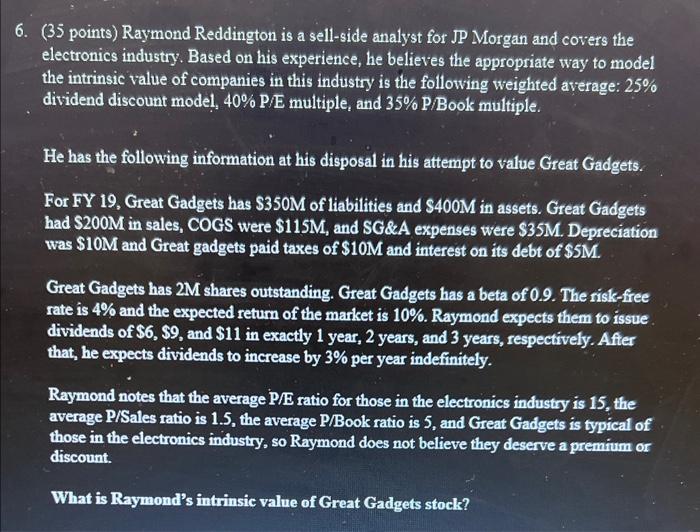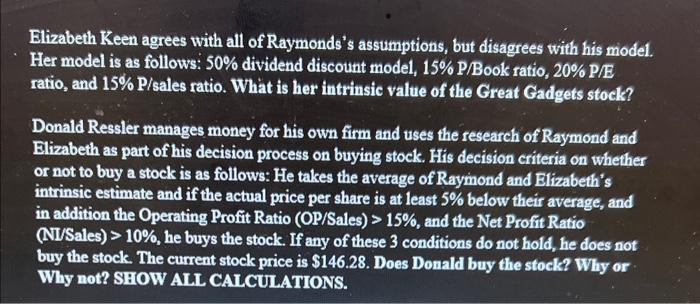Please I need help with this Question (Doing it on Excel and showing the cell reference and formulas is preferable)
(35 points) Raymond Reddington is a sell-side analyst for JP Morgan and covers the electronics industry. Based on his experience, he believes the appropriate way to model the intrinsic value of companies in this industry is the following weighted average: 25% dividend discount model, 40%P/E multiple, and 35%P/ Book multiple. He has the following information at his disposal in his attempt to value Great Gadgets. For FY 19, Great Gadgets has \$350M of liabilities and \$400M in assets. Great Gadgets had \$200M in sales, COGS were $115M, and SG\&A expenses were $35M. Depreciation was $10M and Great gadgets paid taxes of $10M and interest on its debt of $5M. Great Gadgets has 2M shares outstanding. Great Gadgets has a beta of 0.9. The risk-free rate is 4% and the expected return of the market is 10%. Raymond expects them to issue. dividends of $6,$9, and $11 in exactly 1 year, 2 years, and 3 years, respectively. After that, he expects dividends to increase by 3% per year indefinitely. Raymond notes that the average P/E ratio for those in the electronics industry is 15 , the average P/S Sales ratio is 1.5, the average P/Book ratio is 5 , and Great Gadgets is typical of those in the electronics industry, so Raymond does not believe they deserve a premium or discount. What is Raymond's intrinsic value of Great Gadgets stock? Elizabeth Keen agrees with all of Raymonds's assumptions, but disagrees with his model. Her model is as follows: 50% dividend discount model, 15%P/ Book ratio, 20%P/E ratio, and 15%P/ sales ratio. What is her intrinsic value of the Great Gadgets stock? Donald Ressler manages money for his own firm and uses the research of Raymond and Elizabeth as part of his decision process on buying stock. His decision criteria on whether or not to buy a stock is as follows: He takes the average of Raymond and Elizabeth's intrinsic estimate and if the actual price per share is at least 5% below their average, and in addition the Operating Profit Ratio (OP/Sales) >15%, and the Net Profit Ratio (NI/Sales) >10%, he buys the stock. If any of these 3 conditions do not hold, he does not buy the stock. The current stock price is $146.28. Does Donald buy the stock? Why or . Why not? SIOW ALL CALCULATIONS








